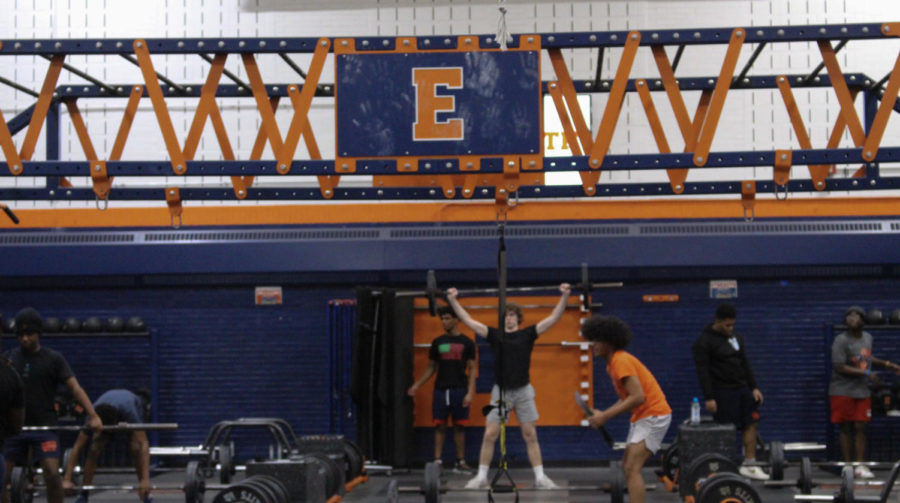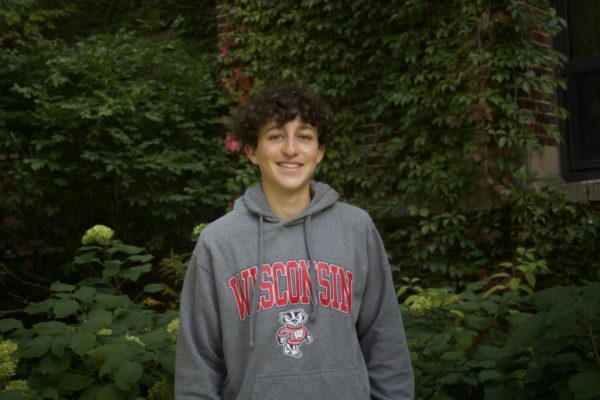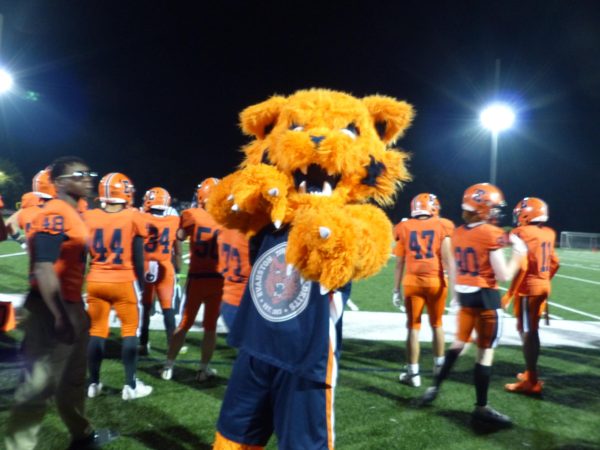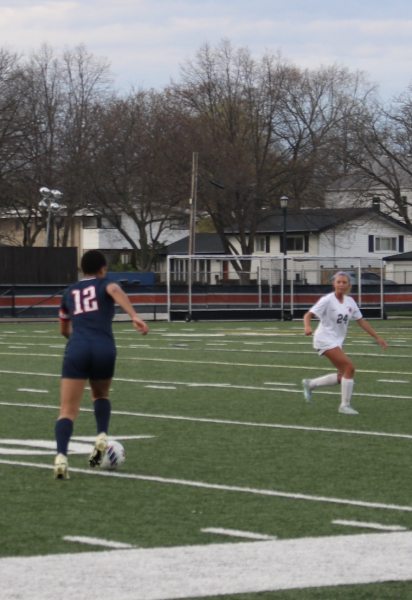Don’t ‘weight’ to start strength
Remodeled in 2019, ETHS’ Michael B. Arrington Wellness and Performance Center provides elite facility, programs for student athletes.
Students train in Michael B. Arrington Wellness and Performance Center after school on Friday, March 10.
March 15, 2023
If you step into G201 any day after school, you’ll see a giant crowd of students strength training for their sport, in a weight room often compared to those of Power 5 colleges across the country. The Michael B. Arrington Wellness and Performance Center, newly renovated in 2019, is often flooded with athletes who have one goal: watching their hard work lifting pay off in competition.
“The stronger I’ve gotten, the harder I’ve been able to throw,” says senior baseball player Mason Denlow. “In my freshman or sophomore year, I was only throwing 78-79 miles per hour. After we came back to school from COVID, I really started lifting and hit a growth spurt and as a result, my [velocity] increased by eight miles per hour, and I’ve gotten a lot stronger.”
Strength Coach Mark Feldner came to ETHS from Niles North in 2019 with the goal to build an entirely new program from scratch. With a new weight facility at his hands, Feldner aimed to create a P.E. class that redesigned how athletes could fit lifting into already jam-packed weeks. The Sport Specific Training (SST) gym class, offered to JV and varsity athletes, has been a game changer for the way athletes are able to train, especially when they’re lifting in-season.
“I wanted to make P.E. a place where athletes feel like they’re really using their time efficiently. One of the opportunities was to help build a widespread in-school program that gives athletes who want to train the chance to do so,” Feldner states.
SST functions as an 85-minute period where students are assigned workouts specifically catered to their sports and are graded based on the length of the workout and the percentage completed.
When students are holding each other accountable, that’s where a widespread uptick happens.
— ETHS Strength Coach Mark Feldner
“One major hump I thought we needed to get over was lifting in-season. After going through a full school day and then having team practice until 6:00, it’s too much to ask of anyone to come in and lift after all that,” said Feldner. “It’s tough because if you’re doing all this work in the off-season, you don’t want your strength to deteriorate when you get to championship season. You want to be as strong as you can possibly be.”
So what exactly does in-season lifting look like? Taxing an athlete’s body while they have practices and games isn’t ideal, but a decrease in strength can lead to a decrease in performance.
“We build the [workout] based on days away from competition. So two days, one day or game day depending on your sport, the lift leads up to competition so you’re in prime condition,” Feldner explains. “It’s all built for recovery and injury prevention that are specific to the nature of the sport.”
Another major aspect of Feldner and the strength team’s work is Powerkits, the elementary and middle school strength training program that runs four days a week after school. Run by Feldner and coaches Sean O’Connor and Maaz Ahmed, as well as other high school athlete volunteers, Powerkits aims to get the future Wildkits familiar with the weight room and solid with lifting technique. For Feldner, he sees it as a great opportunity for younger athletes to get coached by high schoolers who they can look up to.
“The biggest thing with [Powerkits] is peer to peer coaching and responsibility between high schoolers and our younger athletes. As coaches, we can tell you this and that but when students are holding each other accountable, that’s where a widespread uptick happens,” says Feldner.
“We get them strong in technique and how the weight room runs. Having them be coached by older kids that they eventually want to become. It’s a really cool thing to see.”
It’s all built for recovery and injury prevention that are specific to the nature of the sport.
— Mark Feldner
In addition to being a Powerkits volunteer, junior Bella Marinaro participates in a weekly Sunday all-female lifting program run by Coach Lani Peters. The sessions encompass olympic-style lifting that focuses on power cleans and barbell snatches. The two exercises, which require significant technique instruction, have considerably helped Marinaro progress as a runner.
“Coach Lani is a great olympic lifter who comes in and teaches us form. It’s open to all female athletes and just overall, my development across [the sessions] has been huge,” says Marinaro, who long jumps and races in the 400 meter.
“I’ve made so much progress this year– lifting has improved my sprinting power substantially. When I watch slo-mo videos from meets now compared to earlier [this season], I can just see my strength making a difference.”
Those types of results are the exact reason that Feldner coaches.
“Strength and conditioning is really cool compared to sports in the sense that if we try, we’ll win. You can play a basketball or football game and the ball may not bounce your way. The cool thing about [strength] is if you show up, do what you’re told and stay consistent, I guarantee you’ll see really good progress. It builds confidence,” says a smiling Feldner.
“You see it click within every athlete and that’s the fun thing to watch happen.”
To see the strength offerings for this year, check out this video!















